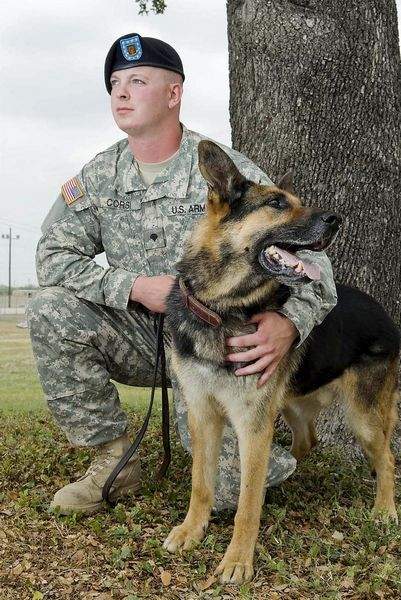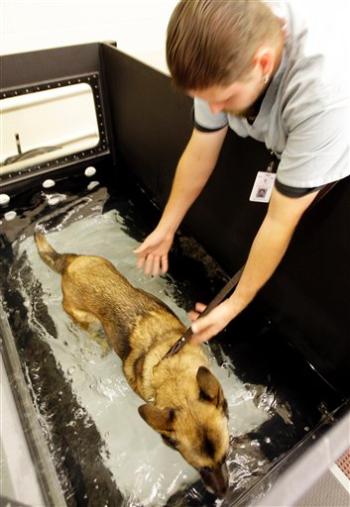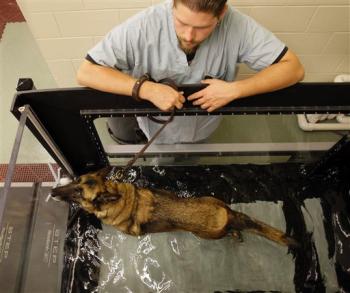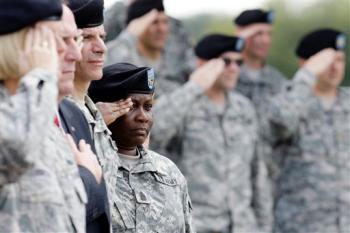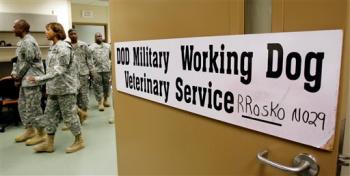Raider K-9 team brings added capabilities to Rashid district
By Sgt. David Hodge, 1st BCT PAO, 4th Inf. Div., MND-B
Blackanthem Military News
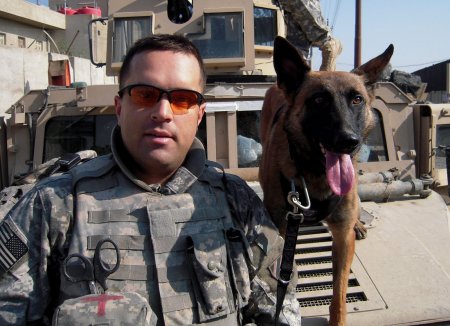
Sgt. James Harrington, a military policeman and dog handler from New Orleans, assigned to the 947th Military Police Detachment, part of the 3rd Infantry Regiment “The Old Guard,” stationed out of Fort Myer, Va., attached to the 1st Special Troops Battalion, 1st Brigade Combat Team, 4th Infantry Division, Multi-National Division – Baghdad, poses with Ryky, a Belgian Malanois, while out on mission Nov. 24 in the Rashid district of southern Baghdad. The duo conducts cache search operations and route clearance in the Rashid district of southern Baghdad. (U.S. Army photo by Sgt. James Harrington, 1st BCT, 4th Inf. Div., MND-B)
FORWARD OPERATING BASE FALCON, Iraq – A Multi-National Division – Baghdad Soldier and his four-legged partner recently joined forces with other military dog teams at Forward Operating Base Falcon in helping to make the streets of Baghdad a safer place for Iraqi citizens and Soldiers to live and operate.
Sgt. James Harrington, a military policeman and dog handler, attached to the 1st Special Troops Battalion, 1st Brigade Combat Team, 4th Infantry Division, along with Ryky, his K-9 partner, patrol the streets and communities of southern Baghdad’s Rashid district to search for weapons and make Soldiers a more effective force.
Harrington, assigned to the 947th Military Police Detachment, part of the 3rd Infantry Regiment “The Old Guard,” stationed out of Fort Myer, Va., and his 3-year-old Belgian Malanois partner, completed approximately 52 missions and uncovered more than 25 finds since arriving to Rashid in October.
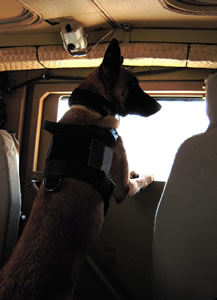
Ryky, a three-year-old Belgian Malanois, is partnered with Sgt. James Harrington, a military policeman and dog handler from New Orleans, who is assigned to the 947th Military Police Detachment, part of the 3rd Infantry Regiment “The Old Guard,” stationed out of Fort Myer, Va., attached to the 1st Special Troops Battalion, 1st Brigade Combat Team, 4th Infantry Division, Multi-National Division – Baghdad. The duo conducts cache search operations and route clearance in the Rashid district of southern Baghdad. (U.S. Army photo by Sgt. James Harrington, 1st BCT, 4th Inf. Div., MND-B)
Harrington said that Ryky made several significant finds since beginning her mission in Baghdad, to include an AK-47 rifle hidden in a false ceiling and four mortar rounds that led to the discovery of a large mound of hollowed-out munitions.
Ryky detects odors from many types of munitions, such as ammunition, weapons, mortar rounds, artillery rounds, homemade explosives and trigger devices with residue on them.
Harrington, a native of New Orleans, said what makes the hollow ceiling discovery so significant is the fact that most K-9s do not acknowledge above space above their own height.
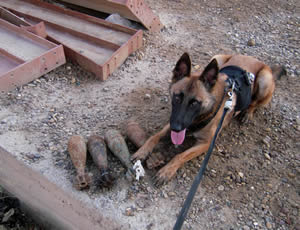
Ryky, a three-year-old Belgian Malanois, rests next to four 60mm mortar rounds she discovered while on patrol Nov. 26 in the Rashid district of southern Baghdad. Sgt. James Harrington, a native of New Orleans, who is Ryky’s handler, is assigned to the 947th Military Police Detachment, part of the 3rd Infantry Regiment “The Old Guard,” stationed out of Fort Myer, Va., attached to the 1st Special Troops Battalion, 1st Brigade Combat Team, 4th Infantry Division, Multi-National Division – Baghdad. (U.S. Army photo by Sgt. James Harrington, 1st BCT, 4th Inf. Div., MND-B)
“Ryky is a very friendly dog,” explained Harrington, a former infantryman in the Marines. “She is not a trained attack dog, so I allow her to be sociable with Soldiers. I let others pet her because it is a big morale booster.”
Harrington met Ryky at the Specialized Service Dog School at Lackland Air Force Base in San Antonio.
“At the school, the dogs are exposed to helicopter rides, simulated gunfire and simulated mortars to see how they react,” said Harrington, a 14-year military service veteran with six deployments since 1995. “The dogs must be confident around the noises; they can’t just take off running.”
Capable of detecting 19 separate odors on the battlefield and the ability to run off of a leash, the SSD dogs have a distinct advantage out in sector, said Harrington.
“Having Sgt. Harrington and the SSD dog gives me the extra capability to unleash the dog into an open area,” said Staff Sgt. Christopher Ogle, who hails from Dayton, Ohio, and is the kennel master for the Falcon K-9 Team, 40th MP Det., from Fort Sill, Okla., attached to the 1st STB.
“It is that off-leash capability that puts the handler out of danger,” he said.
Harrington said he feels the ability to multitask while operating in sector and conducting weapon searches is an important quality dog handlers should possess.
“I have to be able to watch for my security, watch for the dog’s security, watch what she is searching, and finally lead the dog in the direction I want her to search in next,” he explained. “I always have to be two steps ahead.”
Recently, Harrington and Ryky cleared a 600-meter portion of a main thoroughfare in Baghdad for a distinguished visitor; it took them approximately an hour.
“It would take another dog three hours to complete that stretch of road because they would be on a six-foot leash and the handler has to present everything to the dog,” Harrington stated.

Sgt. James Harrington, a military policeman and dog handler from New Orleans, assigned to the 947th Military Police Detachment, part of the 3rd Infantry Regiment “The Old Guard,” stationed out of Fort Myer, Va., attached to the 1st Special Troops Battalion, 1st Brigade Combat Team, 4th Infantry Division, Multi-National Division – Baghdad, poses with Ryky, a Belgian Malanois, in front of a weapons cache they discovered while on mission Oct. 26 in the Rashid district of southern Baghdad. The duo conducts cache search operations and route clearance in the Rashid district of southern Baghdad. (U.S. Army photo by Sgt. James Harrington, 1st BCT, 4th Inf. Div., MND-B)
Usually, the team uses a leash while out in sector due to stray dogs and small confined areas, he added, but, if needed, Ryky could be up to 200 yards away and still effectively search an area.
“It takes me out of the equation in case something was to go wrong; we lose a dog, but we don’t lose a handler,” explained Harrington, who has approximately two years experience with dogs.
According to Harrington, the SSD program has potential and is quickly becoming more widespread across all facets of the military.
One particular advantage of SSDs is the dog graduates ready to deploy right after completing the school, added Harrington.
Normal working dogs leave their school able to detect nine odors and receive additional training by their handlers in theater, said Harrington.
It is said in the “dog world” that the dog always out ranks the handler because the dog will lead the handler to where the odor originates, said Harrington.
“I think Ryky and I make Soldiers’ jobs easier because we can search faster, the dog can smell better and she leads from the front,” Harrington stated.
In the future, the need for working dogs may increase on the battlefield thanks to their keen sense of smell and ability to discover weapons with minimal Soldier over watch.
The Falcon K-9 Team currently keeps seven dogs in its kennels to support military operations in southern Baghdad, explained Ogle, who has six years experience handling dogs.
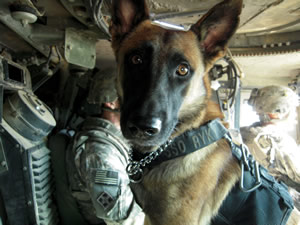
Ryky, a three-year-old Belgian Malanois, is partnered with Sgt. James Harrington, a military policeman and dog handler from New Orleans, who is assigned to the 947th Military Police Detachment, part of the 3rd Infantry Regiment “The Old Guard,” stationed out of Fort Myer, Va., attached to the 1st Special Troops Battalion, 1st Brigade Combat Team, 4th Infantry Division, Multi-National Division – Baghdad. The duo conducts cache search operations and route clearance in the Rashid district of southern Baghdad. (U.S. Army photo by Sgt. James Harrington, 1st BCT, 4th Inf. Div., MND-B)
|

